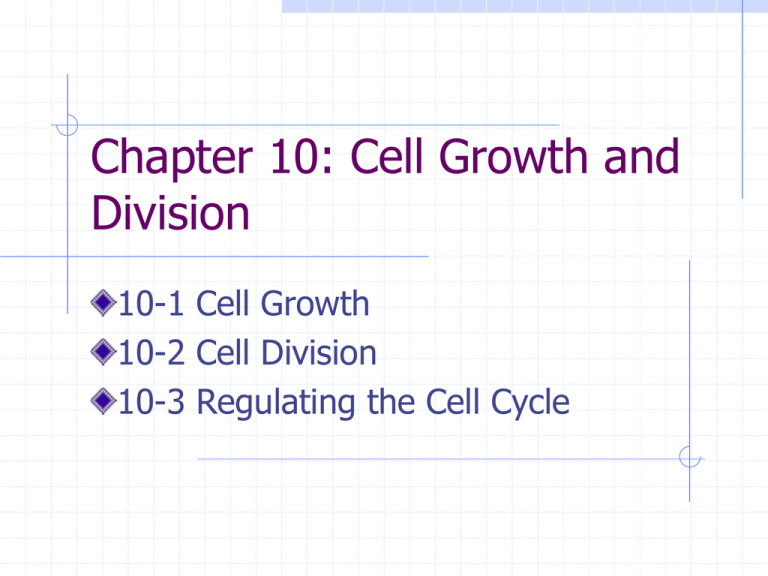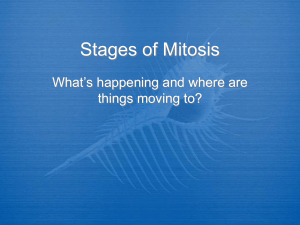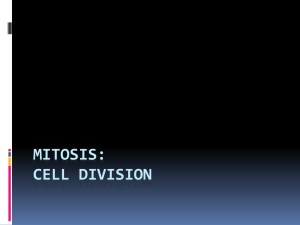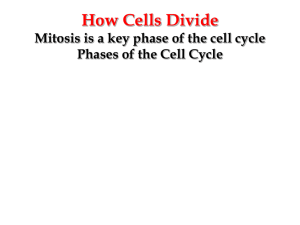Cell Growth Chapter 10 PPT
advertisement

Chapter 10: Cell Growth and Division 10-1 Cell Growth 10-2 Cell Division 10-3 Regulating the Cell Cycle Chapter 10 Concept Map Chromatin Chromosomes Gene Interphase Sister Chromatids Cell Cycle Centromere pg. 244-249 Cyclin Mitosis Prophase Centrioles Metaphase Spindle Anaphase Cell Plate Cleavage Furrow Cytokinesis Telophase 2 Chapter 10 Concept Map pg. 250-252 Results of Mitosis Tissue Organ Organ System Cancer Tumor Types of Skin Cancer Melanomas Squamous Cell Carcinoma Basal Cell Carcinoma Malignant Melanoma 3 Cell Growth Cell size limitations Surface area to volume ratio: The volume of a cell increases faster than its surface area. Diffusion: becomes inefficient at moving necessary materials in and out of cell when volume is too big DNA: makes certain proteins necessary to all organelles. In a large cell without enough DNA, these proteins are not produced quickly enough. “Information crisis” –cell can’t meet all of its needs 4 Cell Division Chromosomes: Condensed clumps of DNA that are visible right before cell division, they unwind soon after. Tightly packed 5 Chromosome Structure (like a ball of yarn) 6 Cell Division The Cell Cycle: The cycle of growth and division of a cell (interphase and mitosis). See Figure 10-4, pg. 245. 7 8 Cell Division Interphase: The growth period of a cell. • 3 Parts: • G1 : The cell grows in size and carries on metabolism (excretion, energy production, making proteins). • S : DNA replicated in preparation for cell division. • G2 : Cell parts needed for cell division are assembled. 9 Cell Division Mitosis: The phase of the cell cycle when the cell begins division; NO VARIATION Occurs when cell size is at a maximum. Occurs in every cell of your body. Four distinct phases, or stages. Prophase Metaphase Anaphase Telophase 10 Prophase First and longest phase of mitosis Chromosomes are visible (DNA condenses) Each half of a replicated chromosome is called a sister chromatid. They are exact copies of each other They are connected by a centromere. Scientists are often able to identify chromosomes by the location of the centromere. 11 Prophase Nucleus and nucleolus dissolve They become no longer visible within the cell By late prophase, centrioles migrate toward opposite ends of the cell. Centrioles: Structures made up of microtubules that aid in separation of sister chromatids. Spindle fibers: many microtubules branching out from the centrioles. Created to pull apart sister chromatids. Plants just have spindle form without the help of centrioles. 12 Prophase Spindle Fibers Chromatid One Chromosome Centrioles 13 Metaphase = middle Metaphase: The centromeres on the sister chromatids become attached to the spindle fibers. The chromatids are then lined up in the middle of the cell. Each centromere has one spindle fiber on either side (one for each chromatid). These fibers come from the centrioles. 14 Metaphase One spindle fiber for each chromatid that makes up the chromosome Metaphase in an Onion All chromosome line up in the middle 15 Anaphase = away, apart Anaphase: the sister chromatids are separated The centromeres split and the sister chromatids are pulled apart. The chromatids are pulled by the spindle fibers toward the centrioles at the poles of the cell. 16 Anaphase Chromatids are pulled by spindles, and separate 17 Anaphase in an Onion Telophase Telophase: Phase is characterized by cleavage furrow, or cell beginning to split its cytoplasm into two distinct daughter cells. Chromatids are now far away from each other. Chromosomes begin to unwind Spindle breaks down Nucleolus reappears Nuclear envelope forms again around chromosomes 18 Cytokinesis Cytokinesis: Cytoplasm of cell divides. Occurs after telophase. In a plant cell, a cell plate is laid down to separate the contents of the two cells. Plasma membranes form inside these new cell walls that have been created. 19 Telophase leading into cytokinesis Cell wall formation Telophase into cytokinesis in an Onion 20 I-P-M-A-T Interphase Prophase Metaphase Anaphase Telophase 21 Control of the Cell Cycle A series of enzymes (cyclins, etc.) monitor a cell’s progress from phase to phase. Enzyme production is directed by genes Too many or too few of these enzymes can disrupt a normal cell cycle Also, the wrong enzyme production can disrupt the cell cycle Cancer: a disrupted cell cycle; can result in excessive cell division 22 Control of the Cell Cycle Causes of Cancer Environmental factors Smoking Breast, mouth, lung, pancreatic, liver, etc. Exposure to sunlight (UV Radiation) Basal Cell, Malignant melanoma Diet Genetic Factors Faulty genes Viral infections Basal Cell Carcinoma 23 http://dermis.multimedica.de/doia/image.asp?zugr=d&lang=e&cd=67&nr=61&diagnr=173922 Types of Skin Cancers Basal Cell Carcinoma Most common type of skin cancer affecting the deepest layer of cells of the epidermis. Squamous Cell Carcinoma Second most common type of skin cancer. Malignant Melanoma Most dangerous type of skin cancer arising from pigmented areas of the skin. Incidents of this cancer have increased among young people due to increased sun exposure. 24 ABCDE of Melanoma: http://www.skincancer.org/skin-cancer/melanoma/melanoma_2.html asymmetry, border, color, diameter, evolving Benign Malignant Symmetrical Asymetrical Borders are even Borders are uneven One shade Two or more shades Smaller than 1/4 inch Larger than 1/4 25 Control of the Cell Cycle An interesting fact: Where you live is also an important factor in cancer rates When you move to a different country, your chances of getting different kinds of cancer change to those in your new country. The possibility of your getting certain cancers is no longer the same as it was in your original country Cancer Growth Website 26 Cell Size Limitations Circle Map Volume increases faster than surface area: Cell doubles in size Area increases 4x Volume increase 8x Surface area to volume Cell Size Limitations Diffusion Too slow to transport material in a large cell (BIG volume) DNA Large cells without enough DNA cannot produce proteins fast enough 27 Control of the Cell Cycle Circle Map Enzyme production directed by genes. Enzymes monitor the progress of a cell from phase to phase. Disrupted cell cycle results in cancer. Control of the Cell Cycle Too many or too few disrupt cell cycle Wrong enzyme 28 Cell Cycle Tree Map Cell Cycle Mitosis Interphase Longest phase of the cell cycle Growth phase Prophase Carries out metabolism 1st phase Chromosomes Longest of mitosis duplicated Cell parts assembled Chromosomes visible Nucleus/Nucleolus for cell division dissolve Centrioles migrate to opposite ends of the cell Sister chromatids Metaphase Anaphase Chromatids line up at the equator Attached to the centromere Sister chromatids begin to separate Pulled by spindle fibers Telophase Chromatids at opposite ends Cleavage furrow Cell plate Two daughter cells formed Nucleus and nuclear envelope reappear Cytokinesis 29 Causes of Cancer Tree Map Causes of Cancer Environmental Smoking Sunlight Diet Genetic Faulty genes Viral infections 30 Cell Cycle Flow Chart 31 33 34









